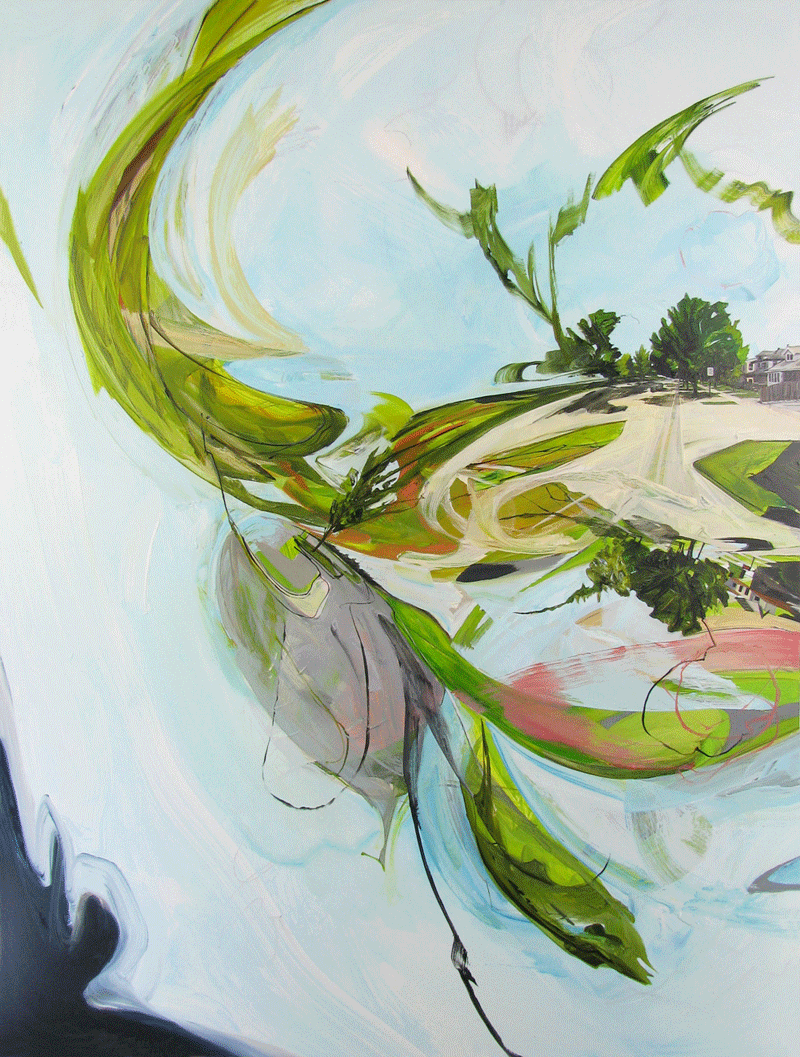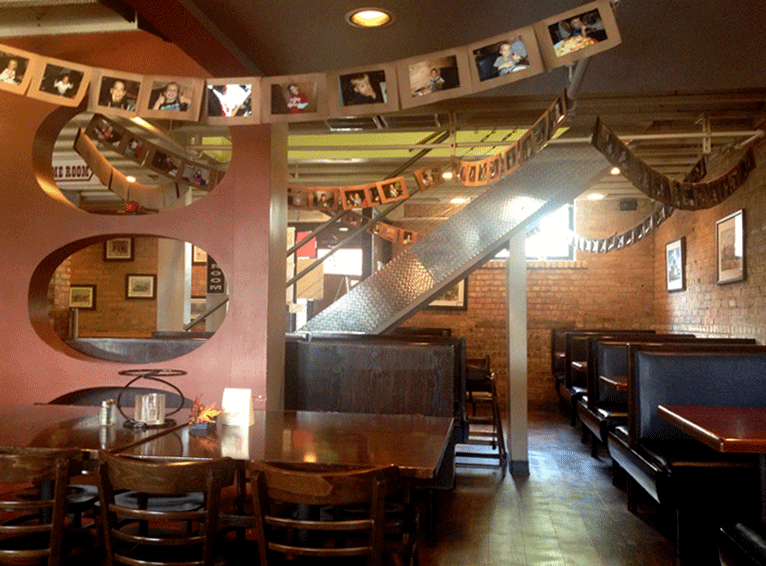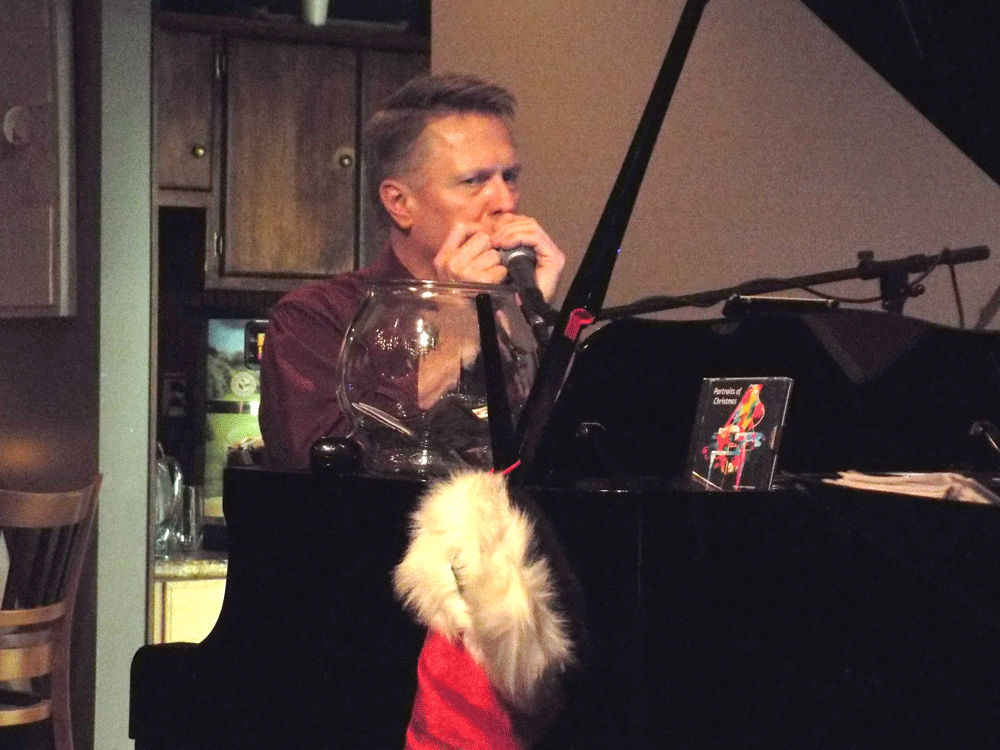There was a time when artist Nathan Taves worked in an office surrounded by blueprints, land surveys and aerial photographs. He studied the details of our city and combined drawing, drafting and tedious accuracy to create books of maps that planners, firefighters and other city officials use to navigate and analyze the chunk of land that we call Fort Wayne. Taves spent years immersed in charts of neighborhoods and networks of roads that tie our community together. During that time his mind played with concepts connected to space and gravity, quantum physics and string theory. Upon viewing his paintings, the influence of this background is obvious. One can almost see the gears turning inside of his head as the rules of space and perspective are questioned and experimented with.
“I am interested in manipulating space having taken my cues from physics and what it says about gravity, relativity and quantum world weirdness,” says Taves when asked about his influences. This man is a thinker who is fascinated by the laws and theories of our physical world. The rigorous, almost painful thinking required for a human brain to comprehend the abstract laws of space and gravity energizes Taves.
“I am not a scientist and I do not understand the math behind scientific formulas. I do struggle to understand the books written by scientists about these topics for laymen like me,” he says. This humble explanation is brought with an enthusiastic tone, his voice energetic, like a scientist on the verge of discovery.
Taves approaches his work with childlike inquiry and thinks of himself as playing with ideas to see what churns out. He has given himself permission to let go of the horizon line so he can look at space in a different way. This artist spends a great deal of time thinking and sketching to establish a framework for each new design. When he finally sets his brush to paint, he doesn’t follow the road map laid out by his sketch; rather, he looks for insight and inspiration as he moves through the painting process, or, as he puts it, “I’m looking for a way to configure space that can surprise and challenge me.”
Taves works with oil paint on hardboard. The materials are both durable and responsive and allow for repeated manipulation. He uses brushes along with napkins, paper towels and Q-tips to apply, wipe away and layer the paint.
The process is tedious. yet he says, “I don’t want the viewer to see the labor involved in getting the painting from the beginning to the point of letting it go. I want the image to seem like a fresh spring plant that just grew that way.
Taves is quick to say he is not an illustrator. He does not create visual diagrams of scientific theory.
“These are poetic interpretations,” he says. “I am using concepts. I am asking questions. What if? I’m not making a statement. I’m asking, what if space can be bent? What would it be like to be in a world where we could see the bends of space?”
While all these thoughts may be as difficult to follow as a movie about time travel, Taves manages to create work that viewers connect with. His palate is consistently cool and calming, dominated by pale blues and greens. At first glance, his pieces appear completely abstract, but given a few seconds of focus, trees become clearly visible, and soon after that clouds and possibly a road, sunset or tiny house can be identified.
“Entering a tree is inserting an anchor within the piece. It gives the viewer something to reference,” said Taves. It seems the familiarity helps people connect with his work. Many collectors who have lived with his paintings say they still get a lot from looking at them, even after years of ownership.
Tave’s paintings easily capture the inquisitive viewer, then reel the mind in as the eye travels around the canvas, connecting with these familiar anchors. The interaction with one of his paintings is similar to a typical approach to thinking about the scientific concepts that his paintings address. Concepts like string theory take a great deal of time to think about, to wrap one’s mind around; often a lifetime of contemplation. Tave’s work is the same. Give it time and thought, let your eyes dive into the paint and you will start to understand. The mind begins to branch out, riding along with Tave’s thought process, up and over hills and between fragmented trees. His work transforms a swirling storm of confusion into a manageable, peaceful world that invites us to wonder and dream.
Taves paints parts of our world that are unseen.
“I am interested in the world we don’t see, but it is still very much a part of our world.” His inspirations include germs, internal organs, gravity, time, string theory and nanoparticles.
His current work is the result of an evolution of his own experiences and artistic experiments. During his sculpture period Taves created representations of internal organs. While the ugliness of innards failed to connect with a broad audience, the study led him to a series of white clay pieces. Void of color, the shapes he created allowed Taves to focus on space and volume.
“So much sculpture is still framed by planes,” he explains. “The ‘Love’ sculpture is simply an extended font. I really wanted to think about space and the white sculptures did that.” One particular sculpture, “Curved World,” was the bridge that changed the course of his work. Taves painted an abstracted landscape upon the white sculpture, and that turned out to be the breakthrough that led him back to the 2D world of canvas and hardboard. Ironically, Taves feels he can most effectively capture ideas of space and perpetual movement on a flat, stationary surface.
While the scientific realm fascinates Taves, he has little interest in responding artistically to society and culture. He is bored by the inflated vocabulary that so many artists use to validate and describe their work, and he feels art is a visual language that shouldn’t have to be explained with lengthy statements. Taves paints for his own fulfillment and doesn’t use self-promotion to push his way into the art world. His life is private, and he keeps images of himself out of the public eye. He chooses to look within and pushes away the constant, superficial distractions that surround us.
“I am not out to reinvent the definition of art or painting,” he explains. “I’m not interested in investigating political or social issues, using imagery from pop culture or the internet age. In the last hundred years scientists have revolutionized our perception of space, time, matter and the size of our universe … In the last hundred years artists have spent a great deal of time thinking philosophically about art, and now we can’t seem to get past all the self-reflection and mind-numbing art-speak. It is like staying in therapy too long.
“My prejudice is simple,” he continues. “I would be very interested if more artists, using what we know from science and physics, would create images and objects that speak to all that fascinating information and all of the rich and inspiring theories. It would be a new type of poetic and theoretical realism that goes far beyond human retinal images.”
 Submit Your Event
Submit Your Event


